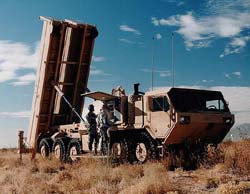US poised to sell advanced anti-missile system to UAE in a $7 billion deal
09 Sep 2008
Washington: In a surprising development, the US government is preparing to notify its legislative body, the Congress, of its intention to sell an advanced missile defence system to the United Arab Emirates (UAE). The deal is estimated to cost up to $7 billion.
The proposed sale would be the first of the so-called Terminal High Altitude Area Defense, or THAAD, a system developed and built by Lockheed Martin Corp. The system's radar is supplied by Raytheon Co.
 US administration and Congress officials have said the advanced anti-missile system would be used to defend infrastructure and logistics in the Emirates region from any hostile action by neighbouring Iran, which has been engaged in developing an ambitious missile programme.
US administration and Congress officials have said the advanced anti-missile system would be used to defend infrastructure and logistics in the Emirates region from any hostile action by neighbouring Iran, which has been engaged in developing an ambitious missile programme.
As a matter of convention, the Congress reviews any such sale within 30 days of notification and generally does not block such administration initiatives.
Meanwhile, Congress officials have been quoted as saying that the UAE has apparently been eager for a "sophisticated antidote" to Iran's missile capabilities. They said the Emirates have been ''concerned'' for a long period of time about ''possible retaliation against it for any US or Israeli strike on Iran's nuclear facilities."
A hostile US or Israeli action against Iran may suck the UAE into a regional conflict for one very good reason that Bahrain's capital city of Manama also serves as home to the US Fifth Fleet and US Naval Forces Central Command (NAVCENT).
Iran had recently threatened, if attacked, to block the Straits of Hormuz.
The proposed $7 billion sale would include anti-missile interceptors, launchers, fire control and communications systems, radar and training among other things, Congressional sources said. It is not clear whether the UAE would also seek the Patriot missile defense system.
THAAD is the first system designed to defend against short- and intermediate-range ballistic missiles both inside and outside the Earth's atmosphere. It complements the lower-aimed Patriot missile defense system, "resulting in a layered defense that ensure a very high probability that ballistic missile threats will be destroyed," according to Lockheed Martin.
Several such land, sea and airborne systems are being woven into an expanding US anti-ballistic missile defence shield.
However, US officials cautioned that any deployment of the THAAD system is "at least months away" and could even take more than a year. Delivery of the first batteries of the system to the US military itself are scheduled during the fiscal year starting 1 October, Lockheed has said.
A production contract for the first two THAAD "fire units" was awarded to Lockheed Martin in late 2006.
Craig Vanbebber, a Lockheed Martin spokesman, said several countries had shown interest in buying the THAAD system, "with its significant coverage area and tremendous success in recent testing."
"Lockheed Martin anticipates a strong future for THAAD in the international marketplace," he said.













.jpg)






.jpg)









